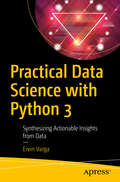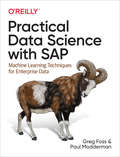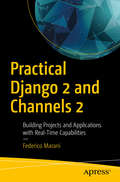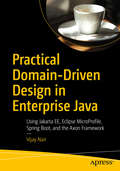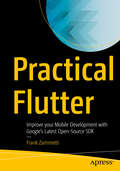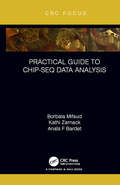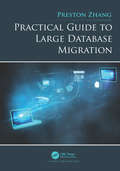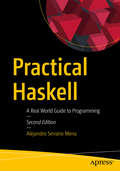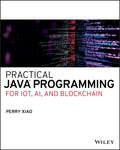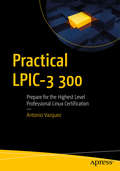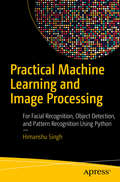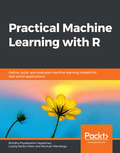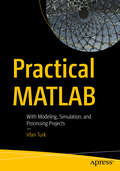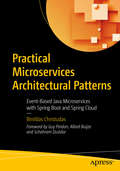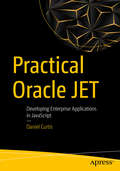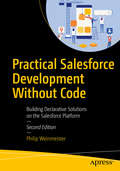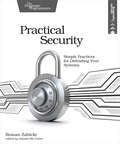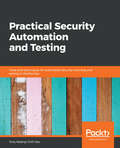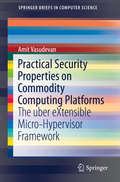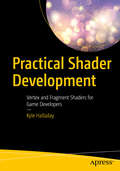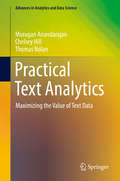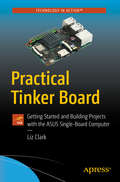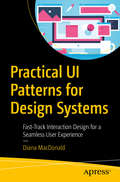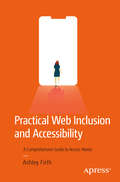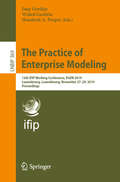- Table View
- List View
Practical Data Science with Python 3: Synthesizing Actionable Insights from Data
by Ervin VargaGain insight into essential data science skills in a holistic manner using data engineering and associated scalable computational methods. This book covers the most popular Python 3 frameworks for both local and distributed (in premise and cloud based) processing. Along the way, you will be introduced to many popular open-source frameworks, like, SciPy, scikitlearn, Numba, Apache Spark, etc. The book is structured around examples, so you will grasp core concepts via case studies and Python 3 code.As data science projects gets continuously larger and more complex, software engineering knowledge and experience is crucial to produce evolvable solutions. You'll see how to create maintainable software for data science and how to document data engineering practices.This book is a good starting point for people who want to gain practical skills to perform data science. All the code will be available in the form of IPython notebooks and Python 3 programs, which allow you to reproduce all analyses from the book and customize them for your own purpose. You'll also benefit from advanced topics like Machine Learning, Recommender Systems, and Security in Data Science.Practical Data Science with Python will empower you analyze data, formulate proper questions, and produce actionable insights, three core stages in most data science endeavors.What You'll LearnPlay the role of a data scientist when completing increasingly challenging exercises using Python 3Work work with proven data science techniques/technologies Review scalable software engineering practices to ramp up data analysis abilities in the realm of Big DataApply theory of probability, statistical inference, and algebra to understand the data science practicesWho This Book Is ForAnyone who would like to embark into the realm of data science using Python 3.
Practical Data Science with SAP: Machine Learning Techniques for Enterprise Data
by Greg Foss Paul ModdermanLearn how to fuse today's data science tools and techniques with your SAP enterprise resource planning (ERP) system. With this practical guide, SAP veterans Greg Foss and Paul Modderman demonstrate how to use several data analysis tools to solve interesting problems with your SAP data.Data engineers and scientists will explore ways to add SAP data to their analysis processes, while SAP business analysts will learn practical methods for answering questions about the business. By focusing on grounded explanations of both SAP processes and data science tools, this book gives data scientists and business analysts powerful methods for discovering deep data truths.You'll explore:Examples of how data analysis can help you solve several SAP challengesNatural language processing for unlocking the secrets in textData science techniques for data clustering and segmentationMethods for detecting anomalies in your SAP dataData visualization techniques for making your data come to life
Practical Django 2 and Channels 2: Building Projects And Applications With Real-time Capabilities
by Federico MaraniLearn how to rapidly build your own ecommerce site by applying Django’s battle-tested components. This book demonstrates Django’s features and conventions to help you develop modern web applications quickly. You'll adopt a "learn by doing" approach and gain a deeper understanding Django by working through a project in which the real-time component will be critical. The book starts with the basics and explains the difference between a Django project and a Django app, the most important settings, how to change them, and the fundamentals of packaging. You'll then be introduced to all the standard tools of Django, along with a sample project. The book then moves on to Channels, a recent addition to the Django ecosystem. It extends the framework with support for real-time operations such as Websockets and other asynchronous features.Practical Django 2 and Channels 2 provides the practical concepts needed to create complex, database-driven websites as easily as possible.What You'll LearnBuild and deploy a simple company site with DjangoDevelop more complex, data-heavy sites using the Django ORMIntegrate Django with ChannelsUnit-test your solutionsWho This Book Is ForPython developers and web developers wanting to learn Django 2 and Channels 2
Practical Domain-Driven Design in Enterprise Java: Using Jakarta EE, Eclipse MicroProfile, Spring Boot, and the Axon Framework
by Vijay NairSee how Domain-Driven Design (DDD) combines with Jakarta EE MicroProfile or Spring Boot to offer a complete suite for building enterprise-grade applications. In this book you will see how these all come together in one of the most efficient ways to develop complex software. Practical Domain-Driven Design in Enterprise Java starts by building out the Cargo Tracker reference application as a monolithic application using the Jakarta EE platform. By doing so, you will map concepts of DDD (bounded contexts, language, and aggregates) to the corresponding available tools (CDI, JAX-RS, and JPA) within the Jakarta EE platform. Once you have completed the monolithic application, you will walk through the complete conversion of the monolith to a microservices-based architecture, again mapping the concepts of DDD and the corresponding available tools within the MicroProfile platform (config, discovery, and fault tolerance). To finish this section, you will examine the same microservices architecture on the Spring Boot platform. The final set of chapters looks at what the application would be like if you used the CQRS and event sourcing patterns. Here you’ll use the Axon framework as the base framework. What You Will LearnDiscover the DDD architectural principles and use the DDD design patternsUse the new Eclipse Jakarta EE platform Work with the Spring Boot frameworkImplement microservices design patterns, including context mapping, logic design, entities, integration, testing, and securityCarry out event sourcingApply CQRS Who This Book Is ForJunior developers intending to start working on enterprise Java; senior developers transitioning from monolithic- to microservices-based architectures; and architects transitioning to a DDD philosophy of building applications.
Practical Flutter: Improve your Mobile Development with Google’s Latest Open-Source SDK
by Frank ZammettiExplore what Flutter has to offer, where it came from, and where it’s going. Mobile development is progressing at a fast rate and with Flutter – an open-source mobile application development SDK created by Google – you can develop applications for Android and iOS, as well as Google Fuchsia.Learn to create three apps (a personal information manager, a chat system, and a game project) that you can install on your mobile devices and use for real. You will begin by getting a solid foundation of Flutter knowledge, and building on it immediately by constructing two more traditional productivity apps.. You will also learn to create a game, enabling you to see a whole other perspective on what Flutter can do. In addition to building these apps, you'll have the benefit of reviewing real-world issues you might encounter, along with ways to deal with them through tips and tricks, all designed to make your Flutter experience that much more productive and, frankly, fun!Practical Flutter will leave you with a solid grasp of how to build apps with Flutter, and springboard into creating more advanced apps on your own. By the time your journey through this material concludes, another larger one will begin as you springboard, well-prepared, into the larger world of Flutter development, tackling any project that comes your way with aplomb. Practical Flutter is a learning adventure you won't want to miss.What You'll LearnGet a Flutter project started and logically structure itUse the interface elements Flutter provides, such as widgets, controls, and extensionsBuild layouts using interface elementsUse available tooling, specifically Android StudioLeverage server-side development and connect a Flutter app to a server back-end. Who This Book Is ForMobile developers who are looking to build for multiple mobile platforms and trying to do so with a codebase that is largely the same across all. Basic knowledge of iOS and Android generally, and some general programming experience is expected.
Practical Guide to ChIP-seq Data Analysis (Focus Computational Biology Series)
by Borbala Mifsud Kathi Zarnack Anaïs F BardetChromatin immunoprecipitation sequencing (ChIP-seq), which maps the genome-wide localization patterns of transcription factors and epigenetic marks, is among the most widely used methods in molecular biology. Practical Guide to ChIP-seq Data Analysis will guide readers through the steps of ChIP-seq analysis: from quality control, through peak calling, to downstream analyses. It will help experimental biologists to design their ChIP-seq experiments with the analysis in mind, and to perform the basic analysis steps themselves. It also aims to support bioinformaticians to understand how the data is generated, what the sources of biases are, and which methods are appropriate for different analyses.
Practical Guide to Large Database Migration
by Preston ZhangIt is a major challenge to migrate very large databases from one system, say for example, to transfer critical data from Oracle to SQL Server. One has to consider several issues such as loss of data being transferred, the security of the data, the cost and effort, technical aspects of the software involved, etc. There a very few books that provide practical tools and the methodology to migrate data from one vendor to another. This book introduces the concepts in database migration with large sample databases. It provides step by step guides and screenshots for database migration tools. Many examples are shown for migrating Oracle, SQL Server and MySQL databases.
Practical Haskell: A Real World Guide to Programming
by Alejandro Serrano MenaGet a practical, hands-on introduction to the Haskell language, its libraries and environment, and to the functional programming paradigm that is fast growing in importance in the software industry. This book contains excellent coverage of the Haskell ecosystem and supporting tools, include Cabal and Stack for managing projects, HUnit and QuickCheck for software testing, the Spock framework for developing web applications, Persistent and Esqueleto for database access, and parallel and distributed programming libraries.You’ll see how functional programming is gathering momentum, allowing you to express yourself in a more concise way, reducing boilerplate, and increasing the safety of your code. Haskell is an elegant and noise-free pure functional language with a long history, having a huge number of library contributors and an active community. This makes Haskell the best tool for both learning and applying functional programming, and Practical Haskell takes advantage of this to show off the language and what it can do.What You Will LearnGet started programming with HaskellExamine the different parts of the languageGain an overview of the most important libraries and tools in the Haskell ecosystemApply functional patterns in real-world scenariosUnderstand monads and monad transformersProficiently use laziness and resource managementWho This Book Is ForExperienced programmers who may be new to the Haskell programming language. However, some prior exposure to Haskell is recommended.
Practical Java Programming for IoT, AI, and Blockchain
by Perry XiaoLearn practical uses for some of the hottest tech applications trending among technology professionals We are living in an era of digital revolution. On the horizon, many emerging digital technologies are being developed at a breathtaking speed. Whether we like it or not, whether we are ready or not, digital technologies are going to penetrate more and more, deeper and deeper, into every aspect of our lives. This is going to fundamentally change how we live, how we work, and how we socialize. Java, as a modern high-level programming language, is an excellent tool for helping us to learn these digital technologies, as well as to develop digital applications, such as IoT, AI, Cybersecurity, Blockchain and more. Practical Java Programming uses Java as a tool to help you learn these new digital technologies and to be better prepared for the future changes. Gives you a brief overview for getting started with Java Programming Dives into how you can apply your new knowledge to some of the biggest trending applications today Helps you understand how to program Java to interact with operating systems, networking, and mobile applications Shows you how Java can be used in trending tech applications such as IoT (Internet of Things), AI (Artificial Intelligence), Cybersecurity, and Blockchain Get ready to find out firsthand how Java can be used for connected home devices, healthcare, the cloud, and all the hottest tech applications.
Practical LPIC-3 300: Prepare for the Highest Level Professional Linux Certification
by Antonio VazquezGain the essential skills and hands-on expertise required to pass the LPIC-3 300 certification exam. This book provides the insight for you to confidently install, manage and troubleshoot OpenLDAP, Samba, and FreeIPA. Helping you to get started from scratch, this guide is divided into three comprehensive sections covering everything you'll need to prepare for the exam.Part 1 focuses on OpenLDAP and topics including securing the directory, integration with PAM and replication. Part 2 covers Samba and teaches you about Samba architecture, using different back ends, print services, and deploying Samba as a stand-alone server, PDC, and Active Directory Domain Controller. Finally, Part 3 explains how to manage FreeIPA and how to integrate it with Active Directory.Practical LPIC-3 300 is the perfect study guide for anyone interested in the LPIC-3 300 certification exam, OpenLDAP, Samba, or FreeIPA.What You'll Learn Integrate LDAP with PAM and NSS, and with Active Directory and KerberosManage OpenLDAP replication and server performance tuningUse Samba as a PDC and BDCConfigure Samba as a domain member server in an existing NT domainUse Samba as an AD Compatible Domain ControllerReplicate, manage, and integrate FreeIPA Who This Book Is For This book is for anyone who is preparing for the LPIC-3 300 exam, or those interested in learning about OpenLDAP and Samba in general.
Practical Machine Learning and Image Processing: For Facial Recognition, Object Detection, and Pattern Recognition Using Python
by Himanshu SinghGain insights into image-processing methodologies and algorithms, using machine learning and neural networks in Python. This book begins with the environment setup, understanding basic image-processing terminology, and exploring Python concepts that will be useful for implementing the algorithms discussed in the book. You will then cover all the core image processing algorithms in detail before moving onto the biggest computer vision library: OpenCV. You’ll see the OpenCV algorithms and how to use them for image processing. The next section looks at advanced machine learning and deep learning methods for image processing and classification. You’ll work with concepts such as pulse coupled neural networks, AdaBoost, XG boost, and convolutional neural networks for image-specific applications. Later you’ll explore how models are made in real time and then deployed using various DevOps tools. All the concepts in Practical Machine Learning and Image Processing are explained using real-life scenarios. After reading this book you will be able to apply image processing techniques and make machine learning models for customized application.What You Will LearnDiscover image-processing algorithms and their applications using PythonExplore image processing using the OpenCV libraryUse TensorFlow, scikit-learn, NumPy, and other librariesWork with machine learning and deep learning algorithms for image processingApply image-processing techniques to five real-time projectsWho This Book Is ForData scientists and software developers interested in image processing and computer vision.
Practical Machine Learning with R: Define, build, and evaluate machine learning models for real-world applications
by Brindha Priyadarshini Jeyaraman Ludvig Renbo Olsen Monicah WambuguUnderstand how machine learning works and get hands-on experience of using R to build algorithms that can solve various real-world problems Key Features Gain a comprehensive overview of different machine learning techniques Explore various methods for selecting a particular algorithm Implement a machine learning project from problem definition through to the final model Book Description With huge amounts of data being generated every moment, businesses need applications that apply complex mathematical calculations to data repeatedly and at speed. With machine learning techniques and R, you can easily develop these kinds of applications in an efficient way. Practical Machine Learning with R begins by helping you grasp the basics of machine learning methods, while also highlighting how and why they work. You will understand how to get these algorithms to work in practice, rather than focusing on mathematical derivations. As you progress from one chapter to another, you will gain hands-on experience of building a machine learning solution in R. Next, using R packages such as rpart, random forest, and multiple imputation by chained equations (MICE), you will learn to implement algorithms including neural net classifier, decision trees, and linear and non-linear regression. As you progress through the book, you'll delve into various machine learning techniques for both supervised and unsupervised learning approaches. In addition to this, you'll gain insights into partitioning the datasets and mechanisms to evaluate the results from each model and be able to compare them. By the end of this book, you will have gained expertise in solving your business problems, starting by forming a good problem statement, selecting the most appropriate model to solve your problem, and then ensuring that you do not overtrain it. What you will learn Define a problem that can be solved by training a machine learning model Obtain, verify and clean data before transforming it into the correct format for use Perform exploratory analysis and extract features from data Build models for neural net, linear and non-linear regression, classification, and clustering Evaluate the performance of a model with the right metrics Implement a classification problem using the neural net package Employ a decision tree using the random forest library Who this book is for If you are a data analyst, data scientist, or a business analyst who wants to understand the process of machine learning and apply it to a real dataset using R, this book is just what you need. Data scientists who use Python and want to implement their machine learning solutions using R will also find this book very useful. The book will also enable novice programmers to start their journey in data science. Basic knowledge of any programming language is all you need to get started.
Practical MATLAB: With Modeling, Simulation, and Processing Projects
by Irfan TurkApply MATLAB programming to the mathematical modeling of real-life problems from a wide range of topics. This pragmatic book shows you how to solve your programming problems, starting with a brief primer on MATLAB and the fundamentals of the MATLAB programming language. Then, you’ll build fully working examples and computational models found in the financial, engineering, and scientific sectors. As part of this section, you’ll cover signal and image processing, as well as GUIs. After reading and using Practical MATLAB and its accompanying source code, you’ll have the practical know-how and code to apply to your own MATLAB programming projects. What You Will LearnDiscover the fundamentals of MATLAB and how to get started with it for problem solvingApply MATLAB to a variety of problems and case studiesCarry out economic and financial modeling with MATLAB, including option pricing and compound interestUse MATLAB for simulation problems such as coin flips, dice rolling, random walks, and traffic flowsSolve computational biology problems with MATLABImplement signal processing with MATLAB, including currents, Fast Fourier Transforms (FFTs), and harmonic analysisProcess images with filters and edge detectionBuild applications with GUIs Who This Book Is ForPeople with some prior experience with programming and MATLAB.
Practical Microservices Architectural Patterns: Event-Based Java Microservices with Spring Boot and Spring Cloud
by Binildas ChristudasTake your distributed applications to the next level and see what the reference architectures associated with microservices can do for you. This book begins by showing you the distributed computing architecture landscape and provides an in-depth view of microservices architecture. Following this, you will work with CQRS, an essential pattern for microservices, and get a view of how distributed messaging works. Moving on, you will take a deep dive into Spring Boot and Spring Cloud. Coming back to CQRS, you will learn how event-driven microservices work with this pattern, using the Axon 2 framework. This takes you on to how transactions work with microservices followed by advanced architectures to address non-functional aspects such as high availability and scalability. In the concluding part of the book you develop your own enterprise-grade microservices application using the Axon framework and true BASE transactions, while making it as secure as possible.What You Will LearnShift from monolith architecture to microservices Work with distributed and ACID transactionsBuild solid architectures without two-phase commit transactionsDiscover the high availability principles in microservicesWho This Book Is ForJava developers with basic knowledge of distributed and multi-threaded application architecture, and no knowledge of Spring Boot or Spring Cloud. Knowledge of CQRS and event-driven architecture is not mandatory as this book will cover these in depth.
Practical Oracle JET: Developing Enterprise Applications in JavaScript
by Daniel CurtisLearn how to use Oracle's JavaScript Extension Toolkit (JET) as a solution to the all too common problem of internal back office and intranet applications that are typically ugly, clunky, and cumbersome to use. JET simultaneously provides you with a JavaScript toolkit that is cutting-edge while being stable enough for enterprise development in an ecosystem that is notorious for its fast-paced rate of change.Practical Oracle JET walks through the process of developing a functional application using Oracle JET. By the end of this book you will have built a support ticket system using a variety of different components bundled with the toolkit, including lists, inputs, and visualizations. The skills acquired from reading this book and working the examples equip you to build your own applications and take your understanding even further to more advanced topics.What You'll LearnBuild a real-world Oracle JET applicationUnderstand the fundamental technologies used in JETControl look and feel through theming a JET application Develop interfaces using Web ComponentsInclude and interface with third-party librariesConfigure automated unit testing of JET applicationsWho This Book Is ForDevelopers with a basic understanding of JavaScript who want to learn Oracle’s JavaScript Extension Toolkit for building client-side applications that can integrate with data services and Oracle Cloud products. The book is also of interest to Oracle ADF developers coming from a Java and WebCenter background who are building new skills in JavaScript and browser-based applications.
Practical Salesforce Development Without Code: Building Declarative Solutions on the Salesforce Platform
by Philip WeinmeisterUse this hands-on guide to build powerful solutions on the Salesforce platform without using a single line of code. This revised and expanded second edition includes Process Builder, Flow Builder, Lightning App Builder, Lightning Bolt Solutions, and more.Practical Salesforce Development Without Code shows you how to unlock the power of the Salesforce platform to solve real business problems. Adhering to Salesforce's "clicks, not code" mantra, Salesforce expert Phil Weinmeister walks Salesforce newcomers and veterans through different business problems and identifies effective—and proven—approaches to solutions using the platform's declarative framework.By adopting this book as your guide, you will learn how to deliver business solutions within Salesforce by combining analysis, creativity, and logic with core elements such as validation rules, workflow rules, processes, flows, formula fields, and Lightning apps. In addition, Weinmeister dissects and explains the most useful functions and features for declarative developers and shows you how to use them. Best of all, Weinmeister uses real-life business scenarios and visuals. Applying the lessons learned from this how-to guide will ultimately save you time and ensure that your clients or internal customers are enabled, equipped, and empowered. What You'll Learn Build objects, fields, and relationships to establish a sensible data modelAutomate business processes by using Workflow, Process Builder, and FlowUtilize functions and develop formulas effectively for a variety of business needsDevelop approval processes to handle exception scenariosEmploy actions to easily create efficient and relevant user experiencesManage your environments and deploy your solutions Who This Book Is forBusiness analysts, Salesforce administrators, and Salesforce developers
Practical Security: Simple Practices for Defending Your Systems
by Roman ZabickiMost security professionals don't have the words "security" or "hacker" in their job title. Instead, as a developer or admin you often have to fit in security alongside your official responsibilities - building and maintaining computer systems. Implement the basics of good security now, and you'll have a solid foundation if you bring in a dedicated security staff later. Identify the weaknesses in your system, and defend against the attacks most likely to compromise your organization, without needing to become a trained security professional. Computer security is a complex issue. But you don't have to be an expert in all the esoteric details to prevent many common attacks. Attackers are opportunistic and won't use a complex attack when a simple one will do. You can get a lot of benefit without too much complexity, by putting systems and processes in place that ensure you aren't making the obvious mistakes. Secure your systems better, with simple (though not always easy) practices. Plan to patch often to improve your security posture. Identify the most common software vulnerabilities, so you can avoid them when writing software. Discover cryptography - how it works, how easy it is to get wrong, and how to get it right. Configure your Windows computers securely. Defend your organization against phishing attacks with training and technical defenses. Make simple changes to harden your system against attackers. What You Need: You don't need any particular software to follow along with this book. Examples in the book describe security vulnerabilities and how to look for them. These examples will be more interesting if you have access to a code base you've worked on. Similarly, some examples describe network vulnerabilities and how to detect them. These will be more interesting with access to a network you support.
Practical Security Automation and Testing: Tools and techniques for automated security scanning and testing in DevSecOps
by Tony Hsiang-Chih HsuYour one stop guide to automating infrastructure security using DevOps and DevSecOpsKey FeaturesSecure and automate techniques to protect web, mobile or cloud servicesAutomate secure code inspection in C++, Java, Python, and JavaScriptIntegrate security testing with automation frameworks like fuzz, BDD, Selenium and Robot FrameworkBook DescriptionSecurity automation is the automatic handling of software security assessments tasks. This book helps you to build your security automation framework to scan for vulnerabilities without human intervention.This book will teach you to adopt security automation techniques to continuously improve your entire software development and security testing. You will learn to use open source tools and techniques to integrate security testing tools directly into your CI/CD framework. With this book, you will see how to implement security inspection at every layer, such as secure code inspection, fuzz testing, Rest API, privacy, infrastructure security, and web UI testing. With the help of practical examples, this book will teach you to implement the combination of automation and Security in DevOps. You will learn about the integration of security testing results for an overall security status for projects.By the end of this book, you will be confident implementing automation security in all layers of your software development stages and will be able to build your own in-house security automation platform throughout your mobile and cloud releases.What you will learnAutomate secure code inspection with open source tools and effective secure code scanning suggestionsApply security testing tools and automation frameworks to identify security vulnerabilities in web, mobile and cloud servicesIntegrate security testing tools such as OWASP ZAP, NMAP, SSLyze, SQLMap, and OpenSCAPImplement automation testing techniques with Selenium, JMeter, Robot Framework, Gauntlt, BDD, DDT, and Python unittestExecute security testing of a Rest API Implement web application security with open source tools and script templates for CI/CD integrationIntegrate various types of security testing tool results from a single project into one dashboardWho this book is forThe book is for software developers, architects, testers and QA engineers who are looking to leverage automated security testing techniques.
Practical Security Properties on Commodity Computing Platforms: The uber eXtensible Micro-Hypervisor Framework (SpringerBriefs in Computer Science)
by Amit VasudevanThis SpringerBrief discusses the uber eXtensible Micro-hypervisor Framework (uberXMHF), a novel micro-hypervisor system security architecture and framework that can isolate security-sensitive applications from other untrustworthy applications on commodity platforms, enabling their safe co-existence. uberXMHF, in addition, facilitates runtime monitoring of the untrustworthy components, which is illustrated in this SpringerBrief. uberXMHF focuses on three goals which are keys to achieving practical security on commodity platforms: (a) commodity compatibility (e.g., runs unmodified Linux and Windows) and unfettered access to platform hardware; (b) low trusted computing base and complexity; and (c) efficient implementation.uberXMHF strives to be a comprehensible, practical and flexible platform for performing micro-hypervisor research and development. uberXMHF encapsulates common hypervisor core functionality in a framework that allows developers and users to build custom micro-hypervisor based (security-sensitive) applications (called "uberapps"). The authors describe several uberapps that employ uberXMHF and showcase the framework efficacy and versatility. These uberapps span a wide spectrum of security applications including application compartmentalization and sandboxing, attestation, approved code execution, key management, tracing, verifiable resource accounting, trusted-path and on-demand I/O isolation.The authors are encouraged by the end result - a clean, barebones, low trusted computing base micro-hypervisor framework for commodity platforms with desirable performance characteristics and an architecture amenable to manual audits and/or formal reasoning. Active, open-source development of uberXMHF continues.The primary audience for this SpringerBrief is system (security) researchers and developers of commodity system software. Practitioners working in system security deployment mechanisms within industry and defense, as well as advanced-level students studying computer science with an interest in security will also want to read this SpringerBrief.
Practical Shader Development: Vertex and Fragment Shaders for Game Developers
by Kyle HalladayIt’s time to stop thinking that shaders are magical. You can use shaders to turn data into stunning visual effects, and get your hands dirty by building your own shader with this step-by-step introduction to shader development for game and graphics developers. Learn how to make shaders that move, tint, light up, and look awesome, all without cracking open a math textbook.Practical Shader Development teaches the theory behind how shaders work. The book also shows you how to apply that theory to create eye-popping visual effects. You’ll learn to profile and optimize those effects to make sure your projects keep running quickly with all their new visuals. You’ll learn good theory, good practices, and without getting bogged down in the math. Author Kyle Halladay explains the fundamentals of shader development through simple examples and hands-on experiments. He teaches you how to find performance issues in shaders you are using and then how to fix them. Kyle explains (and contrasts) how to use the knowledge learned from this book in three of the most popular game engines today. What You'll LearnUnderstand what shaders are and how they workGet up to speed on the nuts and bolts of writing vertex and fragment shadersUtilize color blending and know how blend equations workKnow the coordinate spaces used when rendering real-time computer graphicsUse simple math to animate characters, simulate lights, and create a wide variety of visual effectsFind and fix performance problems in shadersSee how three popular game engines (Unity, UE4, Godot) handle shadersWho This Book Is ForProgrammers who are interested in writing their own shaders but do not know where to start, anyone who has ever seen shader code on a forum and wished they knew how to modify it just a little bit to fit into their own projects, and game developers who are tired of using the default shaders found in the game engines they are using. The book is especially useful for those who have been put off by existing shader tutorials which introduce complex math and graphics theory before ever getting something on the screen.
Practical Text Analytics: Maximizing the Value of Text Data (Advances in Analytics and Data Science #2)
by Murugan Anandarajan Chelsey Hill Thomas NolanThis book introduces text analytics as a valuable method for deriving insights from text data. Unlike other text analytics publications, Practical Text Analytics: Maximizing the Value of Text Data makes technical concepts accessible to those without extensive experience in the field. Using text analytics, organizations can derive insights from content such as emails, documents, and social media. Practical Text Analytics is divided into five parts. The first part introduces text analytics, discusses the relationship with content analysis, and provides a general overview of text mining methodology. In the second part, the authors discuss the practice of text analytics, including data preparation and the overall planning process. The third part covers text analytics techniques such as cluster analysis, topic models, and machine learning. In the fourth part of the book, readers learn about techniques used to communicate insights from text analysis, including data storytelling. The final part of Practical Text Analytics offers examples of the application of software programs for text analytics, enabling readers to mine their own text data to uncover information.
Practical Tinker Board: Getting Started and Building Projects with the ASUS Single-Board Computer
by Liz ClarkGet started with the ASUS Tinker Board and begin building and expanding your own projects. This book covers the basic operating systems offered by ASUS for the Tinker Board and Tinker Board S, TinkerOS and Android, and then dives deeper into its capabilities for projects; such as a music streamer or a weather display with internet connectivity. Beginners will find the resources necessary to follow along and more seasoned makers can review additional information to engage with this new single-board computer platform. The projects are broad enough to show off the capability of the Tinker Board’s hardware and they can be used as is or you can add to them based on your skill level. The ASUS Tinker Board offers an increase in hardware specs and, as a result, is more powerful compared to other single-board computers on the market, making it a great option for projects that would have previously been a challenge to run on other boards, such as the Raspberry Pi. Single-board computers in general are also gaining in popularity as solutions for many DIY tech projects, ranging from gaming to file storage to being a small form factor desktop Linux computer. Practical Tinker Board is a great resource to the maker community, enabling people to begin truly exploring the Tinker Board. What You’ll Learn:Review ASUS Tinker Board's capabilities and functionsGain a deeper understanding of different Linux distributionsBuild useful projects with a range of hardware and softwareTake an in-depth look at how to install, configure and use ASUS Tinker Board in projectsWho This Book Is For:Those who have previously worked on some beginner maker projects, such as basic Arduino and Raspberry Pi projects, and are looking to expand their skills and knowledge of Linux, single board computers, programming and project builds.
Practical UI Patterns for Design Systems: Fast-Track Interaction Design for a Seamless User Experience
by Diana MacDonaldUnderstanding UI patterns is invaluable to anyone creating websites for the first time. It helps you make connections between which tools are right for which jobs, understand the processes, and think deeply about the context of a problem. This is your concise guide to the tested and proven general mechanisms for solving recurring user interface problems, so that you don't have to reinvent the wheel. You'll see how to find a pattern you can apply to a given UI problem and how to deconstruct patterns to understand them in depth, including their constraints. UI patterns lead to better use of existing conventions and converging web standards. This book shows you how to spot anti-patterns, how to mix and match patterns, and how they inform design systems. By helping the non-web professionals and junior web professionals of the world use basic patterns, the web industry can put its best foot forward as new interfaces such as VR/AR/MR, conversational UIs, machine learning, voice input, evolving gestural interactions and more infiltrate the market. Given the emerging popularity of design systems and space of DesignOps, as well as the rise of companies competing on design and usability, now is the time to think about how we use and evolve UI patterns and scale design systems. What You'll LearnProduce intuitive products through consistency and familiarity.Save time instead of starting from scratch.Communicate design decisions with evidence to support solutions.Use smart defaults without extensive product design experience.Improve a user's experience.Scale growing business with design. Who This Book Is For Those familiar with creating websites and want to learn more, WordPress bloggers, or marketers who want to weave components together into a usable, revenue-generating experience.
Practical Web Inclusion and Accessibility: A Comprehensive Guide to Access Needs
by Ashley FirthThe web has to be inclusive. One in five people living in the UK have a disability. From Microsoft’s “inclusive design” movement - creating adaptive controllers for users with a range of disabilities - to Beyoncé’s site being sued for failure to be accessible, the importance of considering access needs is gaining mainstream attention. Recognizing and catering for a range of disabilities in our online platforms is key to achieving a truly inclusive web.You’ll be guided through a broad range of access needs, the barriers users often face, and provided practical advice on how your sites can help rather than hinder. Going beyond advice tailored solely for developers, this book offers potential improvements for designers, developers, user experience professionals, QA and testers, so that everyone involved in building a website can engage with the concepts without the need to understand how to code.Learn about the very latest technology - such as natural language processing and smart home tech - and explore its application accessibly. This book comes complete with practical examples you can use in your own sites and, for the first time in any web accessibility book, access needs experienced by those with mental health disorders and cognitive impairments are comprehensively covered. Applicable to both new projects and those maintaining existing sites and looking for achievable improvements on them, Practical Web Inclusion and Accessibility gives you all the information you need to ensure that your sites are truly accessible for the modern, inclusive web.What You Will LearnUnderstand the vast range of disabilities that have online access needsApply the practical steps required to cater for those needsUse new technology to open up exciting avenues for the sites you create and maintainApproach accessibility from a full spectrum of online disciplinesStart thinking about users with specific disabilities and how it impacts your workWho This Book Is ForAnyone who wants to have a greater understanding of the inclusive web and considerations that should be made. You do not need to have coding knowledge.
The Practice of Enterprise Modeling: 12th IFIP Working Conference, PoEM 2019, Luxembourg, Luxembourg, November 27–29, 2019, Proceedings (Lecture Notes in Business Information Processing #369)
by Wided Guédria Henderik A. Proper Jaap GordijnThis volume constitutes the proceedings of the 12th IFIP WG 8.1 Conference on the Practice of Enterprise Modeling held in November 2019 in Luxembourg, Luxembourg. The conference was created by the International Federation for Information Processing (IFIP) Working Group 8.1 to offer a forum for knowledge transfer and experience sharing between the academic and practitioner communities. The 15 full papers accepted were carefully reviewed and selected from 35 submissions. They are grouped by the following topics: modeling and ontologies; reference architectures and patterns; methods for architectures and models; and enterprise architecture for security, privacy and compliance.
